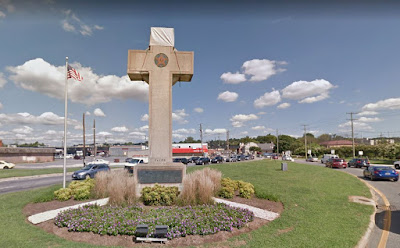 |
| The Bladensburg Peace Cross |
The Supreme Court of the United States has ruled that an historic, cross-shaped monument may be preserved on public land because it does not violate the Constitution’s Establishment Clause.
Cultural property watchers may not have noticed the case of American Legion et al. v. American Humanist Assn. et al. that the United States Supreme Court decided last month and which preserved the display of a cross-shaped war memorial on public property. That’s because the case received greatest attention from religious liberty practitioners and constitutional lawyers monitoring the fate of the controversial Lemon test, which the high court first articulated in 1971 in its landmark decision of Lemon v. Kurtzman—a judicial test that assesses whether there is improper government endorsement or hindrance of religion.
The American Legion case should interest heritage preservationists, nevertheless, because it tackles the recurring question of how public governments are to maintain historic monuments that contain religious symbolism.
Already the outcome of the supreme court’s ruling in the American Legion case has prompted the nation’s highest court to ask the Eleventh Circuit Court of Appeals to revisit the matter of City of Pensacola, Florida v. Kondrat’yev so that it can reassess whether Pensacola can keep an historic World War II era cross monument erected in a public park.
The American Legion case focused on the intersection between the preservation of a World War I memorial and the terms of the U.S. Constitution’s Establishment Clause. In a 7-2 decision, the supreme court voted to keep the Bladensburg Peace Cross standing, writing, “As our society becomes more and more religiously diverse, a community may preserve such monuments, symbols, and practices for the sake of their historical significance or their place in a common cultural heritage.” “The passage of time gives rise to a strong presumption of constitutionality.”
Citizens in Maryland broke ground in 1919 to build the Peace Cross in order to honor the Great War’s fallen soldiers. The American Legion assumed responsibility for the construction of the memorial, and the 32 foot tall monument shaped in the form of a Latin cross was completed in 1925.
The American Legion, a 501(c)(19) nonprofit veterans organization, passed title of the monument and the land in 1961 to the Maryland-National Capital Park and Planning Commission (the Commission) so that the county agency could maintain the historic memorial. Meanwhile, the veterans group retained the right to assemble around the monument for remembrances.
The Peace Cross displays the American Legion emblem, the names of fallen soldiers, a quotation by President Woodrow Wilson, and the script “Dedicated to the heroes of Prince George’s County, Maryland who lost their lives in the Great War for the liberty of the world.” Today it stands at the crossroads of a busy intersection and in the vicinity of other war monuments constructed after 1925.
The American Humanist Association (AHA) filed a complaint with the Commission in 2012, arguing that a Christian symbol could not occupy a public space without violating the First Amendment’s prohibition that “Congress shall make no law respecting an establishment of religion….”The AHA and others thereafter filed suit to raze, dismember, or relocate the Bladensburg Cross. The American Legion entered the case as an intervenor in order to preserve the long-standing monument.
The AHA lost in federal district court but scored a victory in the Fourth Circuit Court of Appeals. The U.S. Supreme Court, however, reversed the appellate court.
Rejecting the AHA’s claim to dismantle the veterans memorial, Justice Samuel Alito wrote on behalf of the supreme court to say, “As our society becomes more and more religiously diverse, a community may preserve such monuments, symbols, and practices for the sake of their historical significance or their place in a common cultural heritage.” “Even if the original purpose of a monument was infused with religion, the passage of time may obscure that sentiment.”
He pointed to Notre Dame Cathedral in Paris, an active church that was consumed by fire in April, as an example that “[w]ith sufficient time, religiously expressive monuments, symbols, and practices can become embedded features of a community’s landscape and identity.” Notre Dame “is fundamentally a place of worship … but its meaning has broadened. For many, it is inextricably linked with the very idea of Paris and France.” In the same way, “the [Latin] cross had become a symbol closely linked to [World War I].”
Justice Alito wrote that “World War I monuments have endured through the years and become a familiar part of the physical and cultural landscape,” which is why “requiring their removal would not be viewed by many as a neutral act.” He added:
Thus, a campaign to obliterate items with religious associations may evidence hostility to religion even if those religious associations are no longer in the forefront.
For example, few would say that the State of California is attempting to convey a religious message by retaining the names given to many of the State’s cities by their original Spanish settlers—San Diego, Los Angeles, Santa Barbara, San Jose, San Francisco, etc. But it would be something else entirely if the State undertook to change all those names. Much the same is true about monuments to soldiers who sacrificed their lives for this country more than a century ago.
The supreme court’s decision means that future disputes surrounding monuments shaped with religious imagery will be reviewed in full historical context. Moreover, Tennessee Solicitor General Andrée Sophia Blumstein sees four key takeaways from the case:
1. There is now a “strong presumption of constitutionality” for long-standing monuments, symbols, and practices with religious associations;
2. When challenged under the establishment clause, such venerable monuments, symbols and practices must be viewed and evaluated in historical context, giving consideration to factors such as (a) whether the monument or practice has taken on a secular meaning or carries a special significance aside from its religious association, (It “is surely relevant” if a monument commemorates particular individuals or has become a “symbol closely linked” to a secular event.), (b) whether the monument has become a prominent community landmark, (c) whether it has taken on historical significance, (d) whether there was discriminatory intent in its design or in the government’s decision to maintain it, and, (e) at bottom, whether the monument, symbol or practice reflects “respect and tolerance for differing views, an honest endeavor to achieve inclusivity and nondiscrimination, and a recognition of the important role that religion plays in the lives of many Americans”;
3. Retaining established, religiously expressive monuments, symbols and practices is “quite different from erecting new ones,” making it clear that the holding is limited to long-standing monuments, symbols and practices and that the presumption of constitutionality does not necessarily attach to new monuments; and, significantly
4. Destroying or defacing a monument with religious imagery that has long stood undisturbed would itself be an act of government hostility towards religion—an act inconsistent with the First Amendment ideals of neutrality, tolerance and respect.
Photo source: Google Maps. Text and original photos copyrighted 2010-2019 by Cultural Heritage Lawyer Rick St. Hilaire, a blog commenting on matters of cultural property law, art law, art crime, cultural heritage policy, antiquities trafficking, looted, antiquities, stolen relics,smuggled antiquities, illicit antiquities, museum risk management, and archaeology. Any unauthorized reproduction or retransmission without the express written consent of CHL is strictly prohibited. The materials presented on this site are intended for informational purposes only and should not be used as legal advice applicable to the reader’s specific situation. In addition, the provision of this information to the reader in no way constitutes an attorney-client relationship. Blog url: https://culturalheritagelawyer.blogspot.com.
©2010-2022 Cultural Heritage Lawyer Rick St. Hilaire. Content discussing cultural heritage law, art law, looted antiquities, stolen artifacts, and museum risk management that is general information only, not legal advice.



